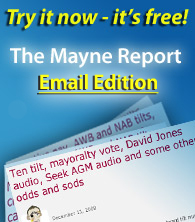An independent process for WA News election
March 12, 2008
Dear candidates, regulators and participants in WA News board spill,
This is just a brief missive from one of the 9 external candidates for the board of WA News at next month's EGM to make the case to all relevent parties that it is completely inappropriate for the incumbent directors, with the support of the Seven Network, to declare that there only be four vacancies created as part of this board spill.
The WAN constitution is clear:
8.1 Appointment and removal of directors
(a) The minimum number of directors is 3. The maximum number of directors is to be fixed by the directors, but must not be more than 10 unless the company in general meeting determines otherwise. The directors must not determine a maximum which is less than the number of directors in office at the time the determination takes effect.
There is no mention anywhere of a requirement that WA only has 4 non-executive directors, making it the smallest board in the ASX100. Directors are within their rights to decree that the status quo remain, but in light of the fact we have 15 candidates, surely it would be more appropriate to allow shareholders to decide the size of the board.
If shareholders want 10 directors, then so be it as it would be entirely constitutional. Kerry Stokes hasn't expressed a view on this, but if the board is trying to prevent him from getting control without paying a premium, then it should open up all the constitutional vacancies. If the board limits the game to 4 non-executive directors, then the Seven Network could very well have 50% of them after April 23.
In terms of Federal policy, the practice at Telstra is most telling here because no other company has faced as many contested elections from large fields of candidates over the years. Ever since floating in 1997, the Telstra policy has always been to leave issues of board size to shareholders, provided it remains within the upper limit prescribed in the constitution. This means that a candidate is successful with more votes in favour than against.
The two main proxy advisory houses, Risk Metrics and CGI-Glass Lewis, also believe that board size is a matter for shareholders, not boards.
How the no vacancy tactic works in practice
I've run for 29 public company boards over the years and in the majority of these cases, the incumbent boards have eschewed the Telstra practice and instead gone down the path being proposed by WAN - that is, limiting the number of vacancies to a figure less than the number of candidates.
When combined with the use of undirected proxies held by the chair, this usually makes it statistically impossible for an outside candidate to be elected.
100% of the directed proxies in favour would not have been enough for me to be elected to the board in any of the following contested elections:
Where 100% of the directed proxies would still fail
NRMA, 2000: 45.07%
ASX, 2000: 69.04%
WA News, 2000: 70.56%
ASX, 2001: 76.6%
CommBank, 2000: 77.43%
David Jones, 2000: 78.53%
AMP, 2000: 80.23%
ASX, 2002: 86.14%
PMP, 2001: 89.11%
NRMA, 2001: 90.39%
NAB, 2000: 90.82%
Southern Cross Broadcasting, 2001: 91%
John Fairfax, 2001: 91.76%
Woolworths, 2006: 93.95%
John Fairfax, 2005: 98.8%
The percentage figure reflects what my 100% vote would have been reduced to after the use of undirected proxies. In each case, the lowest vote for an incumbent directors was higher than the figure listed. Therefore, you have the ridiculous situation at Fairfax in 2005 where 98.8% of the vote in favour would still have failed, because the incumbent directors employed the old "no vacancy" trick.
It appears that the WA News board is proposing to employ this tactic, which probably means they will also implore shareholders to only vote in favour of four candidates, lest the vote be deemed invalid. A far fairer system would be to allow shareholders to vote in favour of any many candidates as they like, and those with a net positive vote are elected, up to maximum of 10.
Time for some independent oversight of WAN process
I've included Federal corporate governance minister Nick Sherry and various parties at ASIC, ASX and the AEC in this missive to make the point that we are in completely unchartered waters here and need some independent oversight of the process.
Never before has an ASX100 company had a complete board spill in which the vote looks like it could be very close. As one of 15 candidates, it is clearly inappropriate for chairman Peter Mansell, whose old firm Freehills wrote the WAN constitution, to preside over the election.
My firm view is that ASIC needs to appoint an independent figure to chair the meeting, in much the same way as Sir Laurence Street was engaged to chair the special general meeting of NRMA in 2002.
Given that Federal law mandates that the Australian Electoral Commission conduct union elections, in this instance I think it would also be appropriate for the AEC to conduct the WA News election.
The two other key areas where I've constistently faced obstacles from ASX-listed companies during contested board elections concern platform censorship and access to the share registry. Like in political elections, all candidates should be given the same information and all candidates should also be able to monitor proxy votes as they arrive, in much the same way that political candidates can appoint scrutineers. Many companies simply refuse to hand over share registers or attempt to charge exorbitant fees, so we need a guarantee that WA News won't employ such tactics.
The WA News board is finalising the notice of meeting this week and I trust that some of you will take an interest in this process to address some of the concerns raised.
Yours Sincerely
Stephen Mayne
PS. Here is a package of other material on the forthcoming contested WAN election.
This is just a brief missive from one of the 9 external candidates for the board of WA News at next month's EGM to make the case to all relevent parties that it is completely inappropriate for the incumbent directors, with the support of the Seven Network, to declare that there only be four vacancies created as part of this board spill.
The WAN constitution is clear:
8.1 Appointment and removal of directors
(a) The minimum number of directors is 3. The maximum number of directors is to be fixed by the directors, but must not be more than 10 unless the company in general meeting determines otherwise. The directors must not determine a maximum which is less than the number of directors in office at the time the determination takes effect.
There is no mention anywhere of a requirement that WA only has 4 non-executive directors, making it the smallest board in the ASX100. Directors are within their rights to decree that the status quo remain, but in light of the fact we have 15 candidates, surely it would be more appropriate to allow shareholders to decide the size of the board.
If shareholders want 10 directors, then so be it as it would be entirely constitutional. Kerry Stokes hasn't expressed a view on this, but if the board is trying to prevent him from getting control without paying a premium, then it should open up all the constitutional vacancies. If the board limits the game to 4 non-executive directors, then the Seven Network could very well have 50% of them after April 23.
In terms of Federal policy, the practice at Telstra is most telling here because no other company has faced as many contested elections from large fields of candidates over the years. Ever since floating in 1997, the Telstra policy has always been to leave issues of board size to shareholders, provided it remains within the upper limit prescribed in the constitution. This means that a candidate is successful with more votes in favour than against.
The two main proxy advisory houses, Risk Metrics and CGI-Glass Lewis, also believe that board size is a matter for shareholders, not boards.
How the no vacancy tactic works in practice
I've run for 29 public company boards over the years and in the majority of these cases, the incumbent boards have eschewed the Telstra practice and instead gone down the path being proposed by WAN - that is, limiting the number of vacancies to a figure less than the number of candidates.
When combined with the use of undirected proxies held by the chair, this usually makes it statistically impossible for an outside candidate to be elected.
100% of the directed proxies in favour would not have been enough for me to be elected to the board in any of the following contested elections:
Where 100% of the directed proxies would still fail
NRMA, 2000: 45.07%
ASX, 2000: 69.04%
WA News, 2000: 70.56%
ASX, 2001: 76.6%
CommBank, 2000: 77.43%
David Jones, 2000: 78.53%
AMP, 2000: 80.23%
ASX, 2002: 86.14%
PMP, 2001: 89.11%
NRMA, 2001: 90.39%
NAB, 2000: 90.82%
Southern Cross Broadcasting, 2001: 91%
John Fairfax, 2001: 91.76%
Woolworths, 2006: 93.95%
John Fairfax, 2005: 98.8%
The percentage figure reflects what my 100% vote would have been reduced to after the use of undirected proxies. In each case, the lowest vote for an incumbent directors was higher than the figure listed. Therefore, you have the ridiculous situation at Fairfax in 2005 where 98.8% of the vote in favour would still have failed, because the incumbent directors employed the old "no vacancy" trick.
It appears that the WA News board is proposing to employ this tactic, which probably means they will also implore shareholders to only vote in favour of four candidates, lest the vote be deemed invalid. A far fairer system would be to allow shareholders to vote in favour of any many candidates as they like, and those with a net positive vote are elected, up to maximum of 10.
Time for some independent oversight of WAN process
I've included Federal corporate governance minister Nick Sherry and various parties at ASIC, ASX and the AEC in this missive to make the point that we are in completely unchartered waters here and need some independent oversight of the process.
Never before has an ASX100 company had a complete board spill in which the vote looks like it could be very close. As one of 15 candidates, it is clearly inappropriate for chairman Peter Mansell, whose old firm Freehills wrote the WAN constitution, to preside over the election.
My firm view is that ASIC needs to appoint an independent figure to chair the meeting, in much the same way as Sir Laurence Street was engaged to chair the special general meeting of NRMA in 2002.
Given that Federal law mandates that the Australian Electoral Commission conduct union elections, in this instance I think it would also be appropriate for the AEC to conduct the WA News election.
The two other key areas where I've constistently faced obstacles from ASX-listed companies during contested board elections concern platform censorship and access to the share registry. Like in political elections, all candidates should be given the same information and all candidates should also be able to monitor proxy votes as they arrive, in much the same way that political candidates can appoint scrutineers. Many companies simply refuse to hand over share registers or attempt to charge exorbitant fees, so we need a guarantee that WA News won't employ such tactics.
The WA News board is finalising the notice of meeting this week and I trust that some of you will take an interest in this process to address some of the concerns raised.
Yours Sincerely
Stephen Mayne
PS. Here is a package of other material on the forthcoming contested WAN election.





















